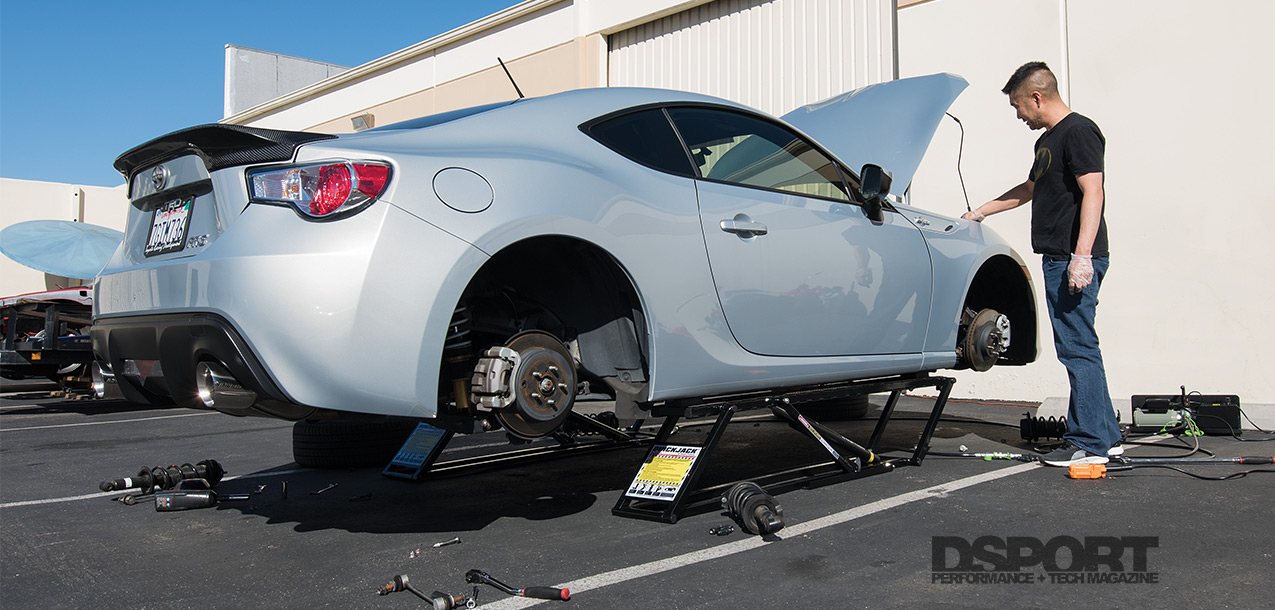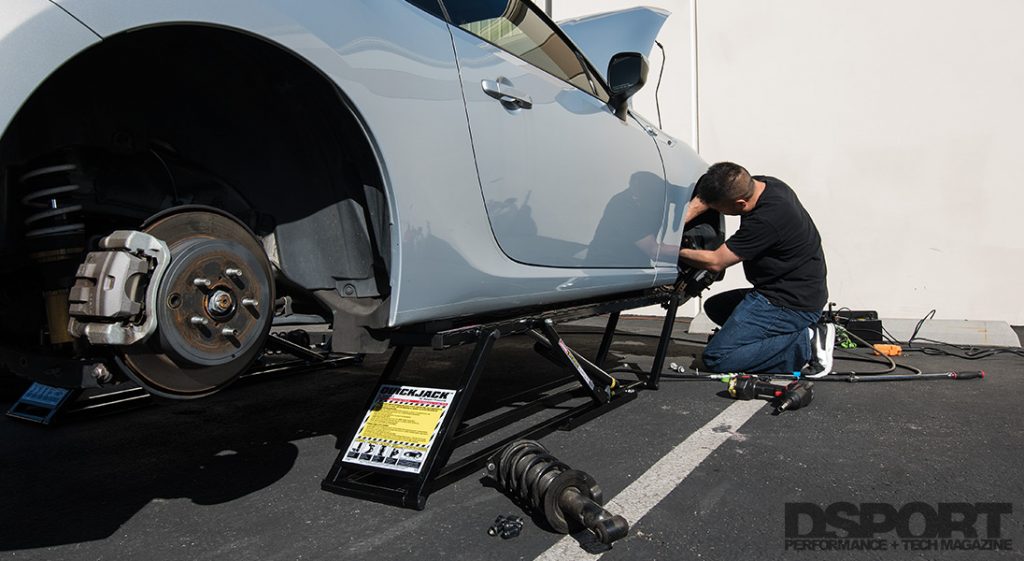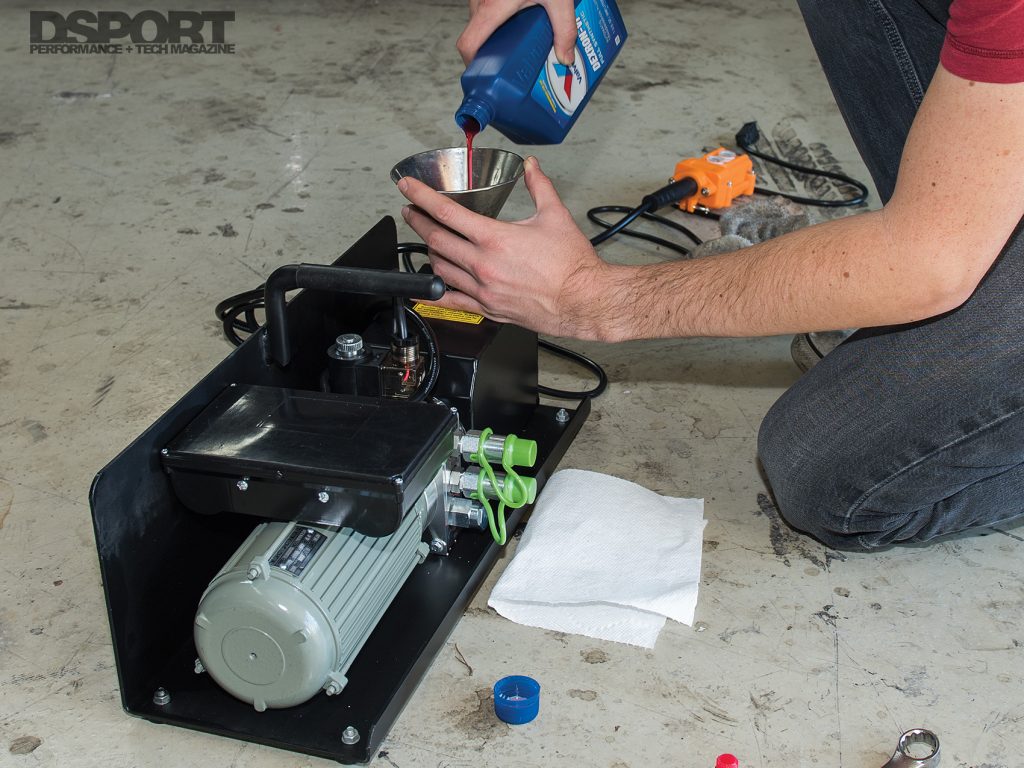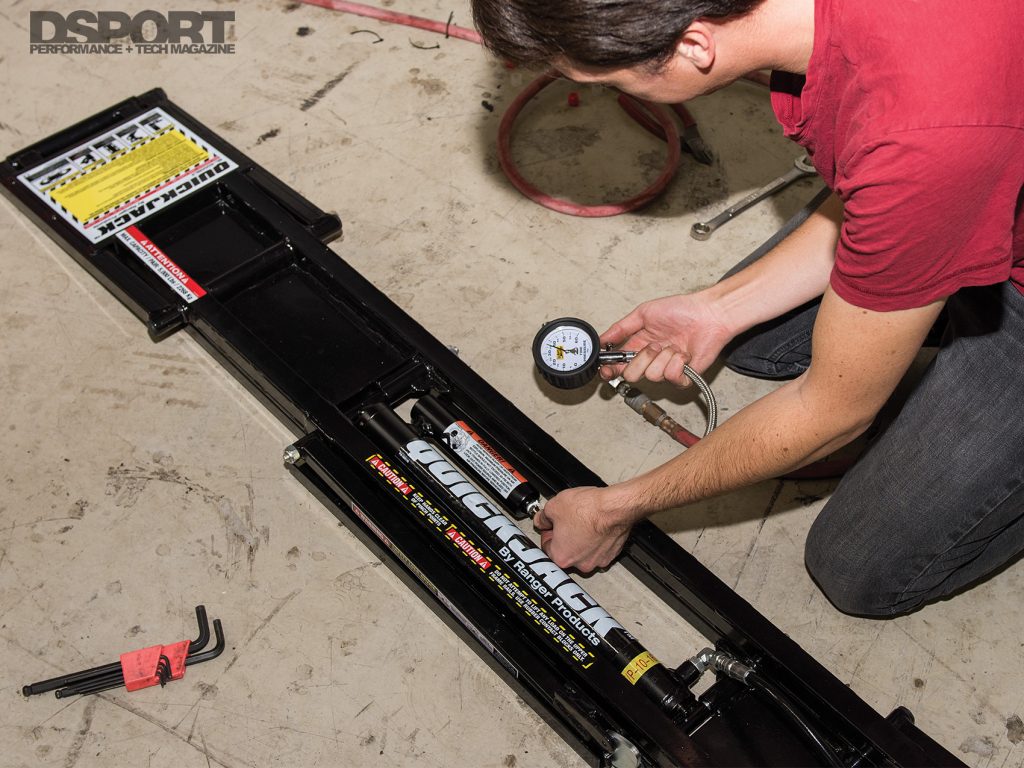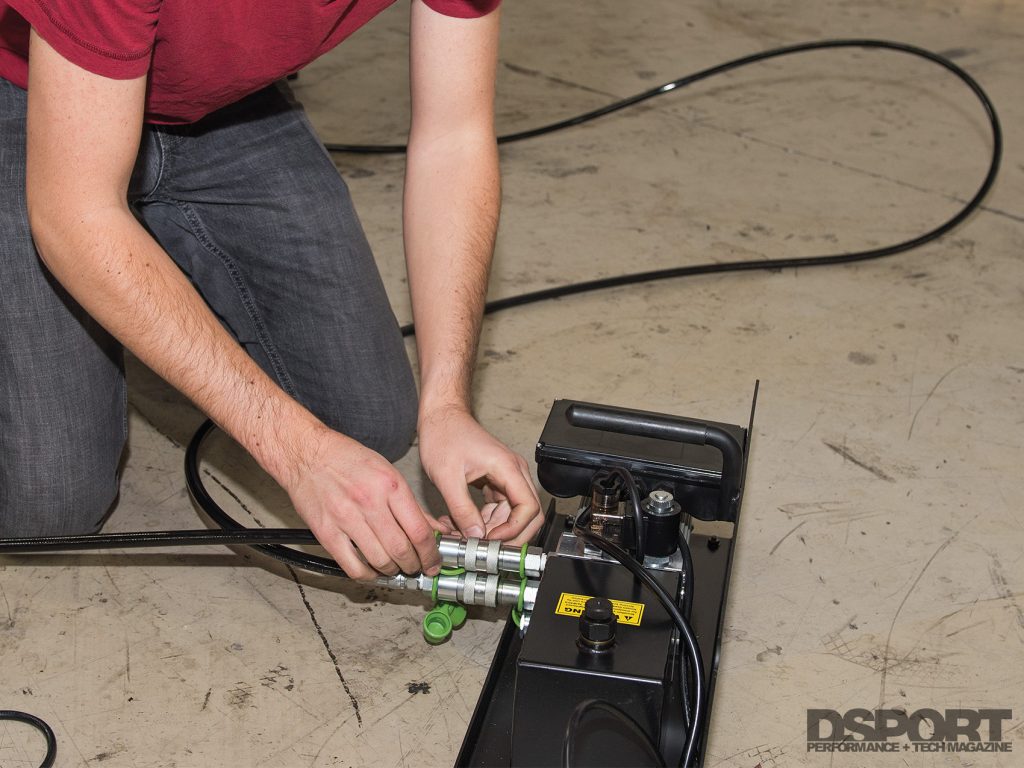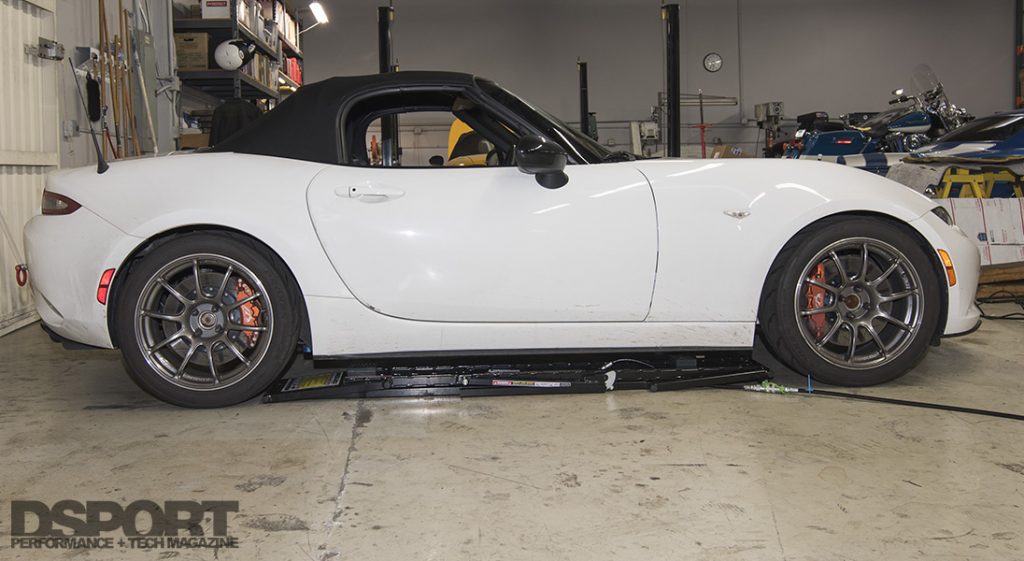This article just might save your life. Many of us forget that when we crawl under a car to perform any sort of repair or upgrade, we’re trusting a lift, jack stands or a simple hydraulic jack to support thousands of pounds of metal from falling on us. It’s a scary thought. Without these tools, wheel and tire changes, transmission swaps and other jobs that take place around and underneath the car would be impossible. The task of enabling these types of jobs without you getting crushed makes lifting equipment one of the most important types of tools you’ll ever own. BendPak’s QuickJack is a portable car lift system designed to exceed the capabilities of conventional jacks and stands that may be a great solution for your garage or trailer.
Text by Cameron Parsons // Photos by Joe Singleton
DSPORT Issue #180
The Problem
Consider some of the most popular methods of lifting a car. For the average home garage, options narrow down to the basic jack and jack stands solution. These tools come in handy for smaller tasks like oil changes and brake pad replacement, but using them for bigger jobs that require all four wheels off the ground is much more of a hassle and potentially dangerous. You’re forced to lift one end of the car at a time, setting half of it down on jack stands as you proceed to lift and prop up the other end. With a narrow base and high-standing prop, some jack stands make it feel like one clumsy step and tripping into the car will send it falling to the ground. Problem areas like these are where a lift system adds some peace of mind.
The QuickJack as a whole is not lightweight. However, the ability to separate the components via quick connect lines makes it much more portable.
How It Works
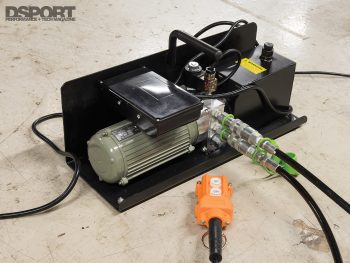 The QuickJack operates similarly to your basic scissor lift. It is offered with a 12V DC, 110V AC or 240V AC power unit, providing options for portability or a more permanent setting in the shop or garage. The system employs a pair of lifting frames that connect to the power unit by way of a hydraulic line with quick connect fittings. The frames don’t allow for a car to drive over them, so they must slide underneath the jacking points after the car is parked. Operation is simple once all of the hardware is in place and the provided rubber blocks are located under the jacking points. A two-button controller lifts the hydraulically actuated frames from fully lowered to maximum height in about 30 seconds. As the frames rise up, the safety lock bars on both sides secure the QuickJack and car from lowering unintentionally. In order to help with the many projects and tech articles that DSPORT produces, we decided to bring one into our shop and give it a try.
The QuickJack operates similarly to your basic scissor lift. It is offered with a 12V DC, 110V AC or 240V AC power unit, providing options for portability or a more permanent setting in the shop or garage. The system employs a pair of lifting frames that connect to the power unit by way of a hydraulic line with quick connect fittings. The frames don’t allow for a car to drive over them, so they must slide underneath the jacking points after the car is parked. Operation is simple once all of the hardware is in place and the provided rubber blocks are located under the jacking points. A two-button controller lifts the hydraulically actuated frames from fully lowered to maximum height in about 30 seconds. As the frames rise up, the safety lock bars on both sides secure the QuickJack and car from lowering unintentionally. In order to help with the many projects and tech articles that DSPORT produces, we decided to bring one into our shop and give it a try.
The Right Choice
BendPak offers three models of the QuickJack for three different weight capacities: the BL-3500SLX (3,500 pounds), the BL-5000SLX (5,000 pounds) and the BL-7000SLX (7,000 pounds). The lifting frames slightly differ among the three options, providing specific advantages for some applications. The BL-3500SLX is the lightest at 180 pounds and most compact with a 62-inch frame length. Given that it is lighter duty and extends to a maximum 50.5-inch length for its lifting points, this model is best fit for subcompacts, sports cars and some race cars. On the opposite end of the spectrum, the BL-7000SLX offers a lift capacity of 7,000 pounds. This model weighs nearly 250 pounds, and sits at 3.5 inches when fully collapsed. It’s intended for larger and heavier duty vehicles like trucks, crossovers and SUVs, and rightfully so since some cars may be too low or have too short of a wheelbase to fit over the collapsed rails.
For the DSPORT shop, we selected the BL-5000SLX, the middle option that is also the most versatile. Its 5,000-pound capacity makes it capable of safely lifting most cars, while its total weight of 212 pounds shared among the primary components makes it lightweight enough to move around the shop. We measure the collapsed height at just under three inches and it spans a length of 72.5 inches, a little on the long side but still suitable for most cars.
The power unit requires 2.5 quarts of automatic transmission fluid to pressurize the lines and hydraulic system.
Cylinders on each frame rail require 50psi of air. Pressure in these cylinders provide folding force for the frames to fully collapse.
The hydraulic lines install with quick connect fittings, making the system easier to move around or store when not in use.
Up and Running
The QuickJack includes all of the necessary hardware to put it together, with little setup required to start lifting. The most notable tasks were to fill the power unit reservoir with 2.5 quarts of automatic transmission fluid, pressurize the air bottle cylinders to 50psi on both frames, install the lines and quick-connect fittings, and bleed air out of the system. Most users will likely require only an hour to finish assembly and setup.
After double checking our work and ensuring that all the fittings were tight, we rolled the D’Garage ND MX-5 into the shop for a test. This car’s wheelbase is shorter than many, so the lifting frames fit between the front and rear tires with only a few inches to spare. The Öhlins Road and Track coilovers also drop it significantly lower than the factory height, leaving only 1-2 inches of clearance between the pinch weld jacking points and the rubber blocks on the lifting frames. The QuickJack requires a small amount of clearance to rise up before it makes contact with the car, so our D’Garage MX-5 was near the lower limits of what the QuickJack allows. Since this MX-5 is a smaller car and sits lower than most, this model of the QuickJack showed that it would comfortably fit underneath most average-sized vehicles.
The QuickJack lifted the car effortlessly and evenly on both sides. The safety lock bars automatically moved into place to prevent the system from lowering back down. With the car in the air, we attempted to rock it side to side to check for stability. There was no significant movement, and it felt much more secure than a regular jack and floor stands would. We did discover one important item to watch out for: the safety lock bars don’t always pass the lock blocks at the exact same time. If you don’t lift the frames high enough for both safety lock bars to clear the lock blocks and then attempt to lower the car back down, you may end up lowering only one side. As long as you follow the directions and pay attention to what you’re doing, you won’t run into this issue.
A Garage-Must
The QuickJack is already getting use around the DSPORT shop, enabling quick and convenient exhaust swaps, suspension changes and more. After a few days of use, we’ve found little to complain about. The frames and power unit aren’t light, but the ability to quickly disconnect and reconnect the lines make moving the separated components around much more doable. Some heavier-looking safety locking bars would add some peace of mind, however, they appear to perform their job effectively as they are. Nevertheless, the QuickJack is both effective and relatively compact, making it an excellent tool to have at the track or in your garage. Better yet, it’s much quicker and safer than the balancing act of using a jack and stands to lift a car off the ground.
Who’s It For?
While professional-grade lifts are priced in the five-digit range, the QuickJack starts at just $1,125.00 for the BL-3500SLX, $1,340.00 for the BL-5000SLX and $1,499.00 for the BL-7000SLX. You may feel tempted to go the cheap route and invest in a hydraulic jack and a set of jack stands for a few hundred dollars instead. However, the QuickJack is miles ahead in terms of pricing, convenience and safety. This makes it irreplaceable for the utility it offers at such a compact size, whether it’s for your home garage or at the race track.
Source
Quickjack
Phone: 1(888) 262-3880


